50 Bodyweight Exercises you can do at Home
Introduction
Bodyweight exercises shouldn’t be combined to be effective, and body workouts shouldn’t be performed with special equipment. There should be a variety of bodyweight exercises that one should add to their at-home training routine to improve their strength both in daily life and about their fitness goals.
For fitness and to make life a little more comfortable, having a solid body must be essential. A person needs whole body muscles to complete any task, whether it is picking up a shifting infant, running a marathon, climbing a flight of stairs, performing quadriceps exercises, or lifting a heavy barbell. Additionally, the better job they will do depends on how powerful their muscle of the body is.
Bodyweight exercises should be realistic and useful, which means that they should help people build stronger muscles that they use every day. When someone does a squat, they are essentially sitting down in a chair, which helps to correct their posture when they are sitting in a chair. When rising from a squat, the person uses their heels and supports their abs. The individual should successfully develop fantastic routines that transform into energies beyond the gym.
Bodyweight workout done with the body weight should help the person to develop good form before adding weight to particular actions. A person might wait to start using weights until they have mastered basic lunge, knee bend, and squat exercises without the use of weights. Bodyweight exercises also have the benefit of allowing a person to complete tasks anywhere and at any time because they always have their own body to use. There would be a better chance for someone to fit into the routine if they had entry to a variety of tasks that they could complete any place.
Bodyweight workouts would help the person gain strength while also training the body to perform more complex weightlifting movements.
How should a person work out their body at home?
It’s also a good idea to switch between unilateral exercises like single-leg glute bridges and bilateral exercises such as squats to create a powerful at-home bodyweight workout, alternate between knee-dominant motions like a lunge and hinge movements like the good morning, balancing exercises
If someone is working out in a circuit style, with exercises done back to back with no rest, it might be a good idea to throw in some light core exercises and upper-body movements. When the stomach and arm muscles are engaged, the leg muscles should take a break, which will also improve the workout’s performance.
There is no ideal number for how many bodyweights exercises the person do own at-home regimen should include but five to eight motions might be a nice repetition to begin for a beginner’s bodyweight workout. When it comes to intensity, beginners should start with two sets of twelve and fifteen reps for each position. If someone finds it enjoyable, they should move on to three sets and then finally four.
Which Bodyweight exercises should someone perform at home?
One easy way to increase the intensity of bodyweight exercises is done without equipment because of the focus primarily on the strength of one leg, single-leg exercises, also known as unilateral exercises, feel more difficult than exercises completed with both legs. thereby, adding movements like lunges, one-legged balance, gluteal bridges, and single-leg calf raises should be a reasonably easy way to increase the intensity of home bodyweight workouts. Simply use one leg to start work.
A person could make bodyweight workouts more challenging by moving with force. sumo squats and jump lunges are supposed to be great exercises that concentrate strength, and power, and might include a little bit of cardio as well.
When conducting bodyweight exercises, it’s important to combine squat variations like squat walk to jump, squat to the oblique crunch and lunges with bending variations like curtsy lunge and forward to reverse lunge. bend exercises mostly target the back of the legs, which includes the hamstrings and glutes muscle, whereas squat exercises normally target the front of the legs, which includes the quadriceps. By combining both types of motions rather than concentrating just on only upper body workout, a person might connect more muscles in their legs and get an improved bodyweight workout.
Important information: If building major strength and muscle is the goal, body weight exercises generally won’t be sufficient. Only when the muscles are overworked and the muscle should actually strengthen and expand. And being overburdened should frequently be caused by weight gain. Body weight exercises, nonetheless, are advantageous for boosting muscular and strength endurance. An individual should have an ideal pathway to increase their level of fitness because they shouldn’t have to worry about weights or any other equipment and should entirely focus on an effective strategy.
How long should the workout last?
Arrange a time duration of 15 to 25 minutes. In 15 to 25 minutes, one could complete a lot. Naturally, the person should extend this time as they get better and stronger. Regardless of how long the bodyweight workout might take, plan a brief warm-up first. As long as the person selects workouts that enhance body temperature, move joints, and activate muscles, warming up shouldn’t be difficult. The individual should be motivated to carry on with exercises
If the person experiences post-workout muscular pain after a bodyweight workout, a further piece of guidance is to wait until the tenderness disappears before beginning another bodyweight-focused activity. Generally speaking, one should wait at least 48 hours before working the same muscle group again. On an active recovery day, stretching the muscles may help the person feel more mobile.
Which muscle is the most challenging to work out?
Each person may have a different challenging muscle to address. A large number of people do, however, occasionally struggle to exercise their smaller muscles. The gluteus medius is a minor but vital lower body muscle.
The glute medius muscle is one of the muscles in the lower body that is extremely important for supporting the hips. It is a member of the hip abductors, a set of muscles that are supposed to move the legs outward, sideways, and far from the body’s center. The outside of the pelvis is where it is situated. People with weak glute muscles frequently experience back and hip pain, which subsequently radiates upward.
It is necessary to pay attention to the glutes and the glute medius during the entire exercise process owing to hip pain and back pain. The glute medius should gain strength with exercises like lateral lunges and curtsy lunges that involve tilting and/or side-to-side motions. Another option is to use a rapid and efficient glute finisher, such as not ignoring the gluteus at the basic level.
50 bodyweight workouts you must do at home
Jumps and single-leg reaches
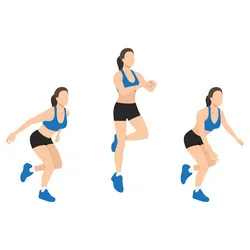
Stand with both of the hands by the sides of the body and the feet hip-width apart.
Reach the left arm to the ground approximately a foot forward of where the left foot was as the person articulates at the pelvis and bend the knees to extend the left leg behind you no higher than the hips.
Jump on the right foot after raising the left knee to stand up straight.
On the opposite side, repeat.
10–15 repetitions, twice daily
muscle involved : calf, quadriceps, glutes maximus,gluteus medius,gluteus minimus muscles
Mountain climbers
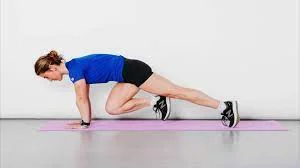
Begin in the plank position, keeping the back erect, the hips low, and the abs firm. By placing the right side elbow beneath the chin, one can pull the right knee toward the right side elbow. Move to the plank position by bringing the left leg under the chest and near the left elbow. A person must maintain a consistent speed while continuing to alternate her or his legs.
10 to 15 repetitions
2-4 times each day
muscle responsible for mountain climbers: shoulders such as rotator cuff muscles include the supraspinatus, infraspinatus, teres minor, subscapularis, hamstring, quadriceps femoris, triceps, core muscles
Gluteal bridge march
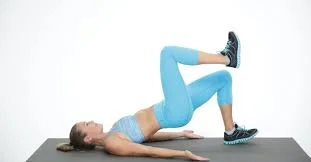
Face up, resting with knees bent and feet hip-width apart. Consequently, the muscles in the core are activated as the lower back presses against the floor.
Squeeze the glutes muscle at the top while keeping the body in this connected position. Stay there. This is the starting place.
The right knee should now be brought up toward the chest as the person lifts the right foot off the floor. stop the marching gluteal bridge motion when the hip is at a 90-degree angle with the ground.
In order to perform the reversed gluteal bridge march on the alternative side, place the foot back down, and then raise the left foot off the floor. One rep counts. Do 10 to 15 repetitions.
As the person moves forward individually, switch up the usage of the feet while holding the hips raised position
3 time day
The muscle responsible for gluteal bridge march: major muscle gluteus
lesser degree muscles hamstring, hips flexor, core, quadriceps
Bodyweight Squat
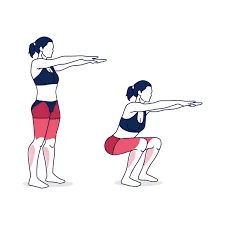
Put both of the hands at the sides with the palms facing inwards to form a standing position. Extend the feet so that they are separated by about hip width. This is where the beginning begins.
Engage the muscles of the abdomen and hold the position with a lifted chest and a flat back while the individual shifts weight to their heels drives the hips back, and bends the knees to lower into a squat. Folding the elbows, bring the hands together in front of the chest. Instead, he or she should basically maintain a constant front-chest position.
Standing on the heels, contract the glutes for one repetition.
Do 10 to 15 reps
2 to 3 times a day
The muscles responsible for bodyweight squat: semitendinosus, semimembranosus, biceps femoris,vastus lateralis,vastus intermedialis,vastus medialis, abdominals, gluteus, gastrocnemius, soleus, rectus femoris
side lying leg elevation
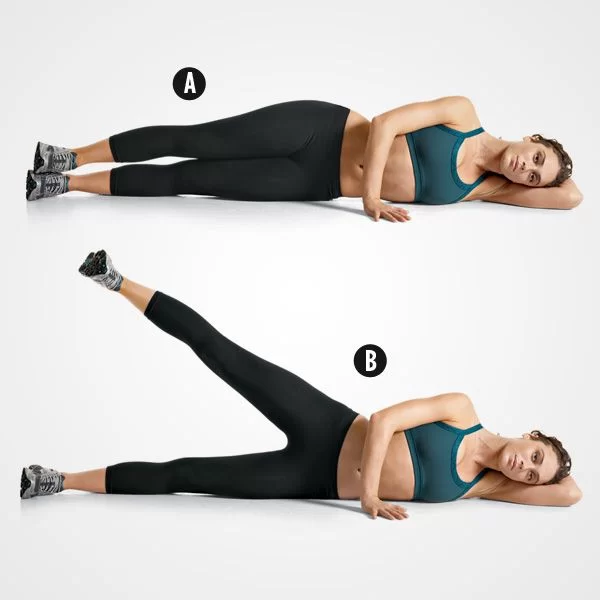
One leg should be placed on top of the other while lying on one side with the legs straight out in front of the ceiling. Place the body flat on the mat or support it with the forearm. the lower body flexed in a downward movement. The side-lying leg raise starts in this posture.
Lift the top leg gradually and gently in the direction of the ceiling. Never raise from the lower back; always do so from the hip and the part of the gluteal region.
Return to the starting location. It’s one rep, then. Do 10 to 15 repetitions.
convert to the other side once an individual completes all the repetitions.
three times per day.
The muscle responsible: outer thigh muscles such as gluteus medius, gluteus minimus, hip abductor, tenor fascia latae, piriformis, sartorius, superior fibers of gluteus Maximus
Bounce Squat
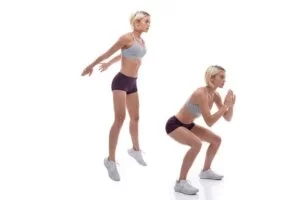
As an individual begins to stand, the feet should be roughly hip-width apart. At this stage, where the beginning is.
Lean the hips forward as the person squats backward. Knees should be bent when the thighs are perpendicular to the ground.
As the person jumps as high into the air as they should be capable of, they should straighten their legs. To produce high speed, keep the back straight and the chest up while hanging the arms by the sides of the body.
move the knee downward on the ground with a relaxed posture. It’s one rep, then. Step carefully into the following squat.
2 to 3 times each session
The muscles include: the gluteus, quadriceps femoris such as vastus medialis, vastus intermedialis, vastus lateralis, rectus femoris, hamstrings such as semitendinosus, semimembranosus, biceps femoris, hips
oblique crunch to squat
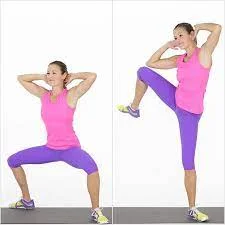
Someone should stand with their feet gradually broader than shoulder-width apart and the palms of the hands touching in front of their chest. The starting position is this.
The person drops into a squat position by grabbing their hips back and bending their knees while they transfer their weight into their heels and keep their back flat and chest up.
Upon rising to the feet, tilt the left knee toward the chest by moving forward. When bending toward the left knee and turning the body to the left, the right elbow should touch the left knee. Return the hands to the starting position as the person lowers the knee.
While squatting once again, repeat the oblique twist on the opposite side. it’s one rep. Do 10 reps.
2 to 3 times a day
The muscle included: obliques and rectus abdominis
Squat to curtsy lunge
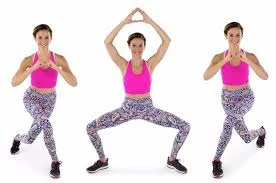
Start with the feet hip-width apart, hands at chest level, and totally engage the abdominal muscles.
Squat until the thighs are level with the ground by moving the hips backward, bending both knees and rotating the hips forward.
To stand, place the right foot diagonally behind the left leg and place the body behind himself/herself.
He or she should flex both knees and squat down while keeping the hips tight and the abdominal muscles engaged.
Go back to the beginning of the squat, and then execute the curtsy lunge from the other side once more. It’s one rep, then. Rotate the other side further.
2 to 3 times each session
muscle included: hamstring, quadriceps, calves, gluteus
eccentric Squat
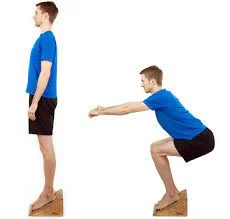
Stand erect with the abdominal muscles linked and the soles of the feet hip-width apart.
The person will attempt to slowly lower themselves into a squat position, bending both knees to at least 90 degrees so that both thighs are parallel to the ground. Since the movement must be eccentric, the rate of motion on the journey downward should be somewhat slower than it would be in a typical squat.
To return to the beginning posture, contract the glutes and stand up rapidly. It’s one rep, then. Do 10 repetitions.
sessions: twice daily
The muscle-included: quadriceps femoris contains vastus medialis, vastus intermedialis, vastus lateralis, rectus femoris
Squat walk to jump
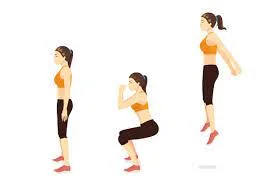
Stand erect with the abdominal region engaged and the feet hip-width apart.
Push the hips back and bend the knees to squat down into a half squat.
While in the squatting position, move the right foot to the right side, allowing the left foot to follow the sequence. Add two extra right-facing steps by using the right foot.
The person dives and extends their legs fully while lifting forcefully. To increase force, extend the arms behind your torso.
The participant is forced to gently contact the ground before sitting down again right away. Repeat on the other side. It’s one rep, then. Do 10 repetitions.
Keep going in opposite directions. twice in day
The muscles responsible: the gluteus, quads, hamstrings, hips
one-legged Gluteal Bridge
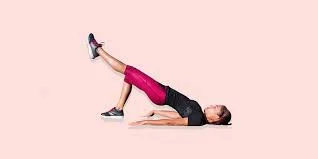
Knees bent, feet flat on the ground, hands at sides of the body, lying face up with the leg up on the floor. By engaging the abdominal muscles, the person places the lower back against the floor.
Stretch the left leg from a one-legged gluteal bridge position by raising the left foot off the floor. The single-leg gluteal bridge is positioned here in its initial position.
Push off the right foot, tighten the abs, and squeeze the glutes while lifting the hips and executing a glute bridge.
progressively lower the pelvis back to the ground. One rep counts.
Every repeat should be done to one side. ten repetitions
three times per day.
muscle responsible: hamstrings, hip flexors, lower back muscles, and gluteal muscles such as gluteus Maximus, gluteus medius, gluteus minimus
Burpees

Put the arms by the sides and stand with your feet shoulder-width apart.
Reach forward and place both hands on the ground while bending the knees.
Then, immediately lowering every part of yourself to the ground while bending at the elbows, kick both legs straight out behind you.
Bounce the legs back under the body and rapidly push the torso back up with the help of your arms.
Jump straight up and swing the arms in the air. The knees must be gradually bent at the end.
muscle included: chest, shoulders, arms, and upper back, core muscle
in, out, center calf raises
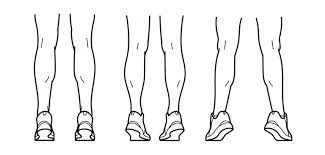
With calf raises the person can more effectively goal the two heads of the gastrocnemius muscle as well as different fibers of the deeper soleus muscle by changing the foot position.
This version would assist the person’s usage all over the muscle fibers in the calf muscle group without weight, creating a great opposite for performing simple calf rises with the toes forward.
When executing the in and out variants of the calf, angle the foot roughly thirty degrees to the inside or outside for every one of the two changes.
There is no requirement for any special instrument for this leg workout, and newcomers should use both legs at once. The single-leg calf exercise is the following phase.
The steps for performing this leg workout utilizing only body weight are as follows:
- When the person places the feet, the heels should hang off the outer edge of the platform or stage. Balance mostly on one leg while supporting yourself with the other if an individual have the strength to do so.
- The person should perform calf rises by pressing into the sole of the foot and rising up onto the tips of the toes.
- While a break, maintain the upward ankle position for two to three seconds.
- Reduce the route gradually until the heel is well down the level of the stairs and the calf muscles are appropriately stretched. Increasing range of motion
- Individuals should move on, the more time they are under stress, and they need to use more muscle for greater results for calf mass and strength
- Toes pointing forward should be utilized for at least 20 to 25 repetitions.
- Then perform the in, out, and center calf raises again while pointing the toes inward. like that, the person is in a pigeon-toed position.
- After that variation, perform the same exercise while standing with your feet together and your toes pointed outward.
The muscle included: gastrocnemius, soleus
The one-legged stair jump
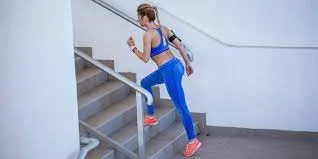
As long as the home has stairs or steps, one of the finest exercises to include in a bodyweight workout without equipment is the single-leg stair jump.
The strength and power of each leg will be developed through the execution of plyometric exercises.
Since it should be a unilateral exercise, the gait pattern accurately replicates the musculoskeletal requirements associated with running or jumping in sports applications.
Additionally, performing unilateral exercises should typically be a better way to strengthen the leg muscles when exercising the legs within weights because the entire body weight must be supported by just one leg, which should provide the person with the overload required for stimulating muscle hypertrophy and increasing strength.
The following procedures must be followed in order to perform the one-leg stair jump without any equipment:
- Standing one foot back from a stair or set of steps, straight and in good posture
- Standing with just the right leg, bending the left knee, elevating the left foot behind the torso.
- He or she should immediately put his or her arms behind themselves or while keeping their core solid as they or lift their body upward and land on the steps of the sole. To engage the glutes and calf muscles, step off on the sole of the foot
- Flex the knee to tone the quadriceps while the person takes the previous step upwards, then press through the foot to stand up straight. come back safely to the beginning point by jumping down. Repeat each repetition on one leg, and then change legs.
- do 10 reps. twice-day
muscle included: calves and glutes, hip flexors, and also involves hamstrings and quadriceps.
Extended leg pulses
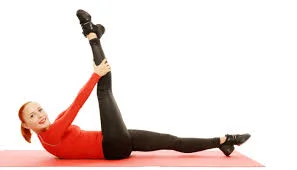
The right leg is extended to the ceiling as the person pulls the right knee to the chest. Maintain the left leg extended and 3 to 5 inches off the ground.
The tips of the fingers should be clasped behind the right knee.
Raise the upper body upward 3 to 5 inches utilizing only the abdominal muscles and not the hands. Ensure that the lower back is securely attached to the ground.
On the opposite side, repeat. Do 10 to 15 reps,2 times a day
muscle involved: quadriceps, rectus femoris, vastus medialis, vastus intermedialis, vastus lateralis
one-legged balance taps
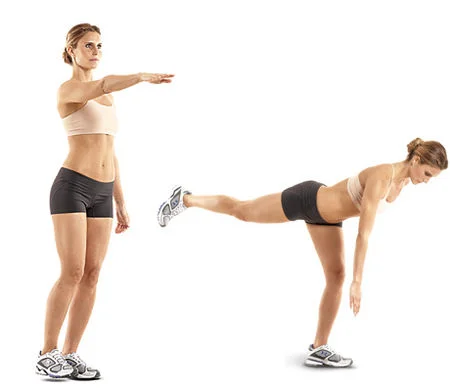
Put the feet together and hold the arms out to the sides.
Lift the right leg straight behind the person as he/she should slowly lean forward at the hips while maintaining a flat back. Reach the right arm down toward the floor.
The right leg should be in line with the body at the bottom of the movement most perpendicular to the floor
Stand up straight while maintaining the core strong and the right leg straight keeping the weight in the left foot.
On the opposite side, repeat. Do 10 to 15 reps
twice a day
muscle responsible: gluteus Maximus, gluteus medius, ankle muscles, core muscle
Curtsy lunge
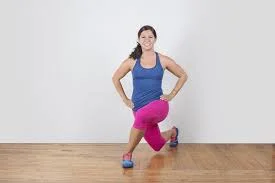
This is a great bodyweight exercise for at-home leg workouts without weights since it is a demanding bodyweight exercise for the legs.
The core’s strength, as well as the quadriceps, glutes, hip abductors, adductors, and hamstrings, will be tested.
Standing with the feet shoulder-width apart, place the hands on the hips or clasp them in front of the chest. The starting position is this.
Right foot back in a diagonal motion with the right knee almost touching the floor. The anterior side of the knee should be flexed to roughly 90 degrees.
push with your left heel to straighten up once more and return to the starting position on the reverse side. Which is one rep. execute 10 reps.
2 or 3 times a day
Kick with Curtsy Lunge
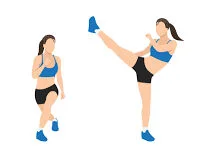
Standing with the feet hip-width apart, the abdominal muscles should be taut. At this stage, where the beginning is.
Flex both knees and take a horizontal step with the right foot behind the left leg to lower theself into a curtsy lunge.
Utilize the left heel to push yourself up to standing. After that, extend the right leg to the left side and try to kick a little while carefully balancing for a little period of time with the right foot.
Put the right foot down and position the foot after the left leg as they will immediately begin the following rep.
Alter the movement to the opposite side once someone has completed all the reps on one side
Do 10 to 15 reps
twice a day
The muscle responsible: primary muscles: Quads, glutes, shoulders, core
accessory muscles: Upper back muscles like trapezius,latissimus dorsi, rhomboid, and levator scapulae, chest muscles like pectorals, arms, hips, thighs
Bear Planks
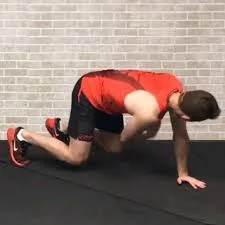
Begin in a tabletop posture on the hands and knees, with the wrists over the shoulders and the knees positioned below the hips.
Just a few inches should separate the knees from the floor. To maintain balance and a flat back, utilize the muscles in the core.
Press the palm of the hand lightly on the knee on the other side. Repeat while switching sides.
Attempt not to rotate the body, and maintain an upright body.
muscle involved: gluteus Maximus, gluteus medius, psoas major, quadriceps, shoulders, arms, and abdominals.
Tuck jump
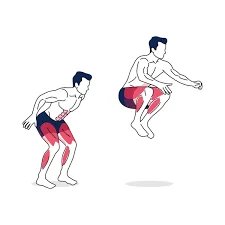
As an individual stands, their feet should be roughly hip-width separated. To preserve straight forearms, bend the elbows while maintaining the arms close to the body and by the sides. The starting position is this.
Knees should be flexed, the gluteal region should be pushed back into a squat, and weight should be moved backward. Ensure that the hips do not extend beyond the knees.
To progress, one person should put up their best effort. With the aid of firm abs and legs related in the direction of the forearms, jump. inhibit from curving forward and keep the back straight.
While landing with the feet hip-width apart, the knees should be relaxed. Execute 10 repetitions. It is one rep Rapidly come back to the squat, then continue.
sessions: twice daily
The muscles responsible: gluteus, semitendinosus, semi-membranous, rectus femoris, calf, obliques, lower back, hip flexor, quadriceps femoris
Lunge in reverse to single-legged hop
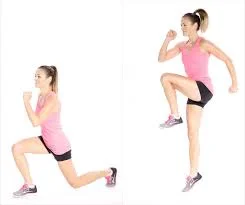
Standing with the feet shoulder-width apart, tighten the muscles in your core. The starting position is this.
Perform a walk backward with the right foot, landing on the right foot’s surface while keeping the right heel off the ground.
twist both knees to 90 degrees as the person moves down into a lunge. Bending the elbows, raise the right arm forward and the left arm back a little bit. You shouldn’t try to extend your gluteal region out, instead, keep the hips folded inward and your abdominal muscles engaged.
Jump as high as possible while thrusting with the left foot and dragging the right knee toward the chest.
To resume the usual position, gently descend on your left foot to do a further lunge
Reposition yourself to take another lunge as you gently descend to the ground on your left foot in the typical position. Executing 10 reps. It is one rep.
Finish all the repetitions on one side. Reverse lunge to single leg hop is then repeated while switching sides.
The muscles responsible: quadriceps femoris, gluteus, hamstring
Squat split
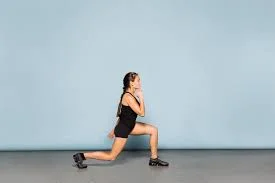
Step forward using the right foot, maintaining the right heel fixed in place as though lunging forward. Put the bottoms of your feet beneath your shoulders. The starting position is this.
flexed both knees to generate a 90-degree angle with the legs. The center of the chest should be upright, and the whole body should be moving forward steadily in order to maintain a straight back that is neither twisted nor curled forward. The right quadriceps should be parallel to the floor and the right knee should extend above the right foot. The body’s core muscles and buttocks should be engaged.
give thrust with the right foot to reset to the starting position. One rep counts.
Execute 10 reps, After finishing all the reps on one side change the side
session: twice a day
muscle responsible: quadriceps femoris such as vastus medialis, vastus lateralis, vastus intermedialis, biceps femoris, gluteus
Switching from a forward to a reverse lunge
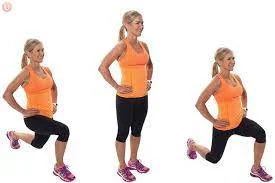
The first time a person stands, the feet should be shoulder-width separated. preserve your hands by your heart. The starting position is this.
Lift the right foot, advance about two miles, then firmly land the foot on the ground. As the person flexes both knees, the left tibia and right quadriceps should be near the floor. The body must lean slightly forward to maintain a flat back that isn’t twisted or oval in shape. The right knee should be beyond the right foot, and the pelvis and core should be engaged.
Applying force to get back to the beginning position, then With the right foot, take a step backward while keeping the heel off the ground. Then, reposition yourself about two feet on the footsole. As the person bends both knees, the left quad and right tibia should be nearly perpendicular to the floor. The body should bend forward progressively so that the back is straight and not twisted or rounded. The left knee should be beyond the left foot, and the pelvis and abdominals should be level.
give thrust using the left foot’s heel to return to the starting position. One rep counts. Do 10 repetitions.
Switch to the second leg once you’ve completed all the reps on the first one.
The muscles responsible: quadriceps femoris, hamstring, gluteus, calf
Single-leg walkout to push-ups
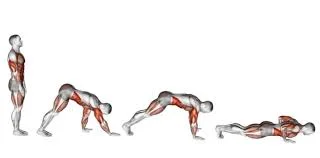
Starting position: hands at sides, feet hip-width apart. the left leg should be raised just a little bit.
With the left leg raised off the floor, drag out to a high plank while bending at the hips to bring the hands to the floor.
Do a push-up with the abs tight and the shoulders above your wrists.
Retract the hands to the feet, then stand up.
On the opposite side, repeat.
Muscle involved: Pectoralis Major chest, Triceps back of upper arm and forearms, Anterior Deltoids (front of shoulder), Lattisimus dorsi upper back, and Core lower back, abs, quads, and calves
Dog Bird Crunches
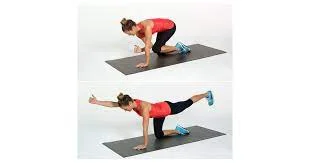
Begin in a tabletop posture on the hands and knees, with the wrists over the shoulders and the knees positioned below the hips.
While maintaining a flat back and keeping the hips level with the floor, exhale and stretch the right arm forward and left leg back.
Draw your right elbow to your left knee while exhaling and contracting your abdominals.
Back out to the starting point.
Ten repetitions
session: twice daily
muscle involved: rectus abdominis, erector spine, gluteus
Donkey Kick
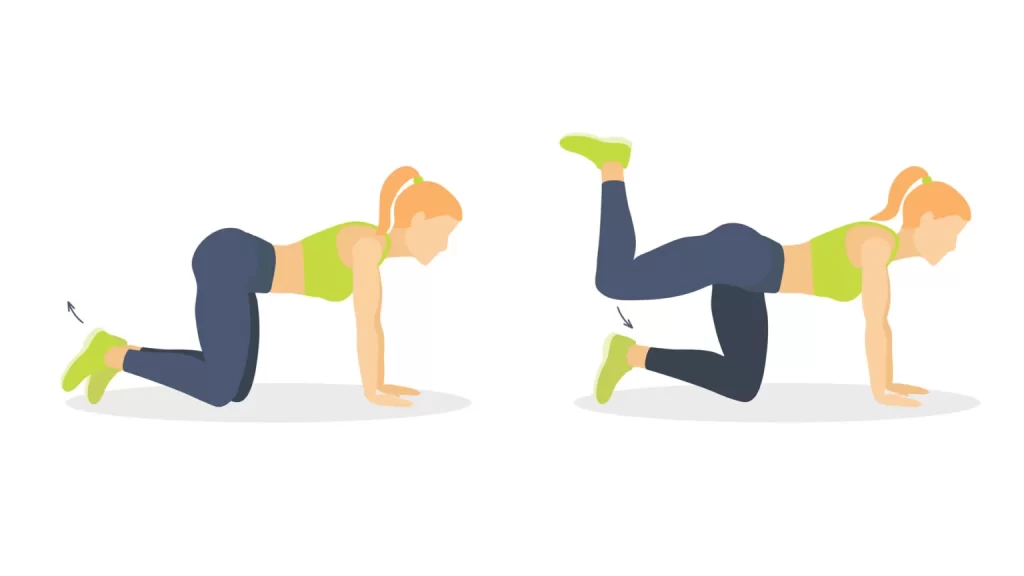
Starting on all fours, tense your abs, and place your wrists and knees under your shoulders.
Kick the right foot up and toward the ceiling by lifting it up with the glutes and hamstrings.
To avoid falling to the left side during rising, pause before extending the person’s arches to the lower back and preserve abdominal stability. Keep in mind that donkey kicks are more of a strength than a flexibility exercise.
move down the leg to the beginning position to complete one rep.
After finishing each rep on one side, switch to the other.
Do 10 to 15 reps
session: twice a day
Muscle responsible: gluteus medius, gluteus minimus
Pop squat with a 180-degree turn

When starting with the feet somewhat wider than hip-width apart, the person’s core should be tight.
After a brief jump into position, quickly make a 180-degree move to indicate the opposite direction.
Move the hips backward, bend both knees, press the glutes to pull yourself down, contact the floor with one hand, and lower yourself into a position of squatting after one more short jump.
Instantly jump once after standing up, then on your second jump, rotate 180 degrees to indicate the opposite direction. Repetition of the jump is followed by a squat on the other side.
Continue circling circularly while jumping and squatting.
execute 5 to 7 reps
Inner thighs opened inverted

Lay on your back with your knees flexed and your feet flat on the ground. Lift the right leg up, extending it upward, keeping the thighs in contact. This is where the beginning begins.
Continue to keep the lower back and hips firmly planted on the floor while gradually extending the right leg out to the right side for the appropriate amount of time.
Bring the leg backward to start. It’s one rep, then. Continue doing 10 repetitions.
Once the participant has finished all the reps, repeat on the opposing side.
session: twice a day
muscle responsible: inner thigh, outer thigh, abdominals
down dog abs
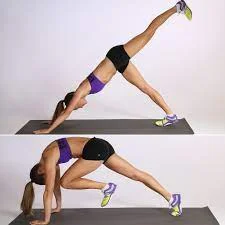
Begin in the downward dog position and extend the right leg. This is the three-legged down dog or the down dog split posture.
the torso by bringing the right knee under it. Retract the right leg to a down dog split after pausing.
Bring the right knee and right elbow together at this point. Retract the right leg to a down dog split after pausing.
Lastly, cross the right leg over the left elbow and across the torso. After a brief rest, move down theself into a down dog abs.
On the other side, repeat the same method.
10 to 15 repetitions.
two times per day.
muscle involved primary muscles: Core, glutes
Secondary muscles: Hamstrings, quads, hips, shoulders, arms
Dead bugs
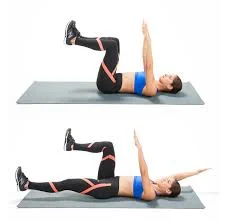
Lie on the back with the arms lifted toward the ceiling at shoulder height. Knees bent 90 degrees and placed over hips, raise the legs into tabletop posture.
Straighten out the right leg slowly while lowering the left arm from the shoulder. the right leg and left arm should stay a few inches off the ground.
Return the leg and arm to their starting positions.
Extend the left leg and right arm as you do the same on the opposite side.
do 10 reps
sessions: 2 to 3 times a day
The muscle responsible: The transverse abdominis (the deepest core muscles that cover surrounding your spine and sides), rectus abdominis (muscles that run vertically along the front of the abdomen), obliques (muscles on the sides of the stomach), and pelvic floor are just a few of the many core muscles
Good morning
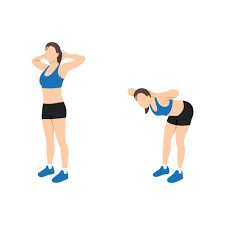
Start by standing upright with your feet hip-width separated and the arms behind your head. The starting position is this.
an individual gradually bends forward, bends at the hips, and engages the core while keeping a flat back and straight legs. Stop the movement when the chest is parallel to the floor.
Return to the starting position after completing one rep. then Ten times in total.
two to three times per day.
Muscle responsible: gluteus, hamstring, upper back,lattisimus dorsi, calves
Froggers
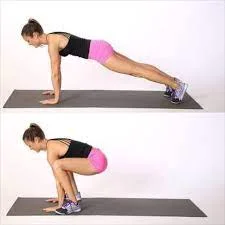
Put your body in a full squat with your feet slightly apart and your thighs parallel to the floor. The head is in the middle, the chin is elevated somewhat, and the lower back is gradually bent. Ahead of the body, the arms are extended.
To assist in helping the legs go off from the full squat posture at an angle of sixty degrees as the arms are raised over the head, take a deep breath, sweep the arms backward, and then fast forward. Prepare to land when you reach the jump’s height. As soon as you land, squat down fully to resume your starting position from the workout.
Your small forward motion will highlight your strength in both the horizontal and vertical directions.
Return to good squat form and perform the jump right away.
Do 5 to 10 times
sessions: twice a day
variations of froggers for greater power and body control
Floating tabletop With straight arms and bowed legs
Simple Frogger: It involves pulling your legs up toward the body while maintaining straight arms.
Slow Toe Pull Frogger: Straight arms, flexed legs, sliding toward your hands
Sumo Frogger: It requires a more flexible hip and has a wide stance and straight arms.
Straight Leg Frogger requires strong shoulders and flexible hamstrings. Straight arms and legs are required.
High frogger: Straight arms, a lot of shoulder pressure, and preparation for the handstand
Any one version isn’t simply better than another, but depending on the requirement, the person might gain by focusing on a particular version over others.
The standard Frogger may be easier to maintain your body weight if you struggle with shoulder stability than the Slow Toe Pull or Straight Leg Frogger. You may concentrate on the Slow Toe Pull Frogger if you want to develop your shoulders and elbows.
Strengthen your upper body strength, control, and hip flexibility by using the variations while you get stronger and more relaxed with the basic Frogger.
muscles responsible
Primary: Quadriceps, gluteus maximus, gastrocnemius, soleus, rectus femoris, vastus lateralis, vastus medialis, and vastus intermedius.
Secondary: Deltoid, rectus abdominis, external and internal obliques, hamstrings (semitendinosus, semimembranosus, biceps femoris).
The benefits of froggers
Basic Frogger: Coordinated and isometric protraction, asymmetrical and unilateral retraction, and asymmetrical control of elevation provide scapular strength.
To regulate asymmetric internal rotation and coordinated, isometric outside rotation, the rotator cuff must be strong. spine’s isometric flexion, rotation, and extension strength, flexibility in the calf and hamstrings improved hip mobility and strength
slow-toe pull frogger: Elbow strength, spinal strength and control, hamstring and calf flexibility, improvements in abdominal and spinal stability.
Sumo Frogger: Spinal strength for isometric rotation, extension, and flexion; elbow and knee stability; Strengthen and expand hip mobility with flexion and abduction.
Straight-leg frogging benefits strength in the rotator cuff, the knees, the spine, and the controlled motion of the hips
High Frogger: Strengthening of the spine, the rotator cuff, the elbow, and the formation of motor coordination as well as control
Dirty dog
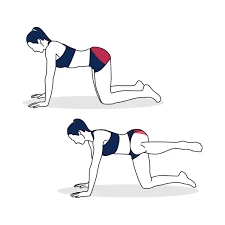
A beginner-level bodyweight exercise that works the body is the dirty dog. When carried out properly, it also activates the center. The dirty dog exercise can be incorporated into any changing warm-up program as well as the lower body or abdominal strength training exercise.
Start on all fours (tabletop) with your hands and knees on the ground. Make utilize an exercise mat as comfort. The hands and knees should be placed squarely below the shoulders. Continue to look forward. This is where everything begins.
Maintain the right knee flexed at a 90-degree angle as the person involves their core and lifts or abduction the right leg away from the body. Kneeling around 45 degrees far from the body, or as high as the flexibility will allow.
For 3 to 5 seconds, hold.
Gradually bring the knee back toward the floor to reverse the motion.
After a short break, perform the repetitions again, ending on the right side before moving to the left.
a fire hydrant, frequently referred to as a dirty dog
muscle involved: hips, gluteus, primarily gluteus medius,
Push-ups Karate

There are many different techniques to perform a push-up. This one is very successful.
Lift the hips while doing push-ups.
The front of the body can be lowered using the arms until your chin is almost touching the floor.
Maintain your legs off the ground as you drop your head, shoulders, and hips upward and downward.
To return to the raised-hip position, reverse the motion.
perform push-ups in karate for 30 to 60 seconds.
muscle involved: abs, chest, back, shoulder, triceps
Calf lifts, and plie squats
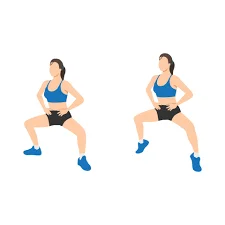
feet increasingly wider than shoulder-width apart, hands on hips or in front of the chest, and toes pointing out.
do squat until the thighs are equal level to the ground. This is the initial position of the calf lifts and pile squats.
Maintain the squat stance for two seconds while lifting both heels off the ground.
Pull the heels back down for one rep. Perform 10 reps twice or three times daily.
muscle responsible: gluteus, calves, inner thigh
Gun Squats
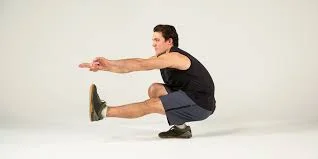
The most challenging bodyweight workout exercises one should perform without any equipment are pistol squats because of the movement’s high control and power needs for the quads, glutes, hips, ankles, and core.
As the person is standing up place the feet together. This is where the pistol squat begins.
The left leg must be lengthened and raised a few inches with the foot flexed.
Twist the right knee, raise the left leg to hip height, and squat backward while bending forward at the hips. Lengthen the arms outward for balance.
If somebody tries to bend their knee to a 90-degree position, it will fail.
If you are not in the beginner group, you should not give up because these are very difficult.
As the person returns to the beginning position, press with the heel of the right leg to straighten it. Continue with the remaining reps.
session: based on the individual’s capacity
Jump Lunge
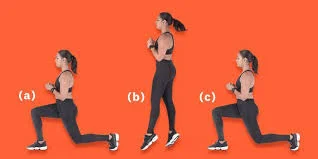
As the subject stands, space their feet about shoulder-width apart. This is where the beginning begins.
While maintaining a stable core, jump with the left foot forward and the right foot backward. Next, lower yourself into a lunge while flexing both knees.
Jump with both feet to come back to the initial position.
Lunge to the opposing side after thrusting the right foot forward and the left foot back. It’s one rep, then. Do 10 repetitions.
Continue jumping while alternating sides each time the subject bends.
To make the jumping lunge technique more challenging, one should alternate the feet in the middle of the action and immediately lower yourself into a lunge every time. This will inhibit an individual from jumping their feet back together
Muscles responsible: hamstring, calves, gluteus, hip flexor
Frog jump
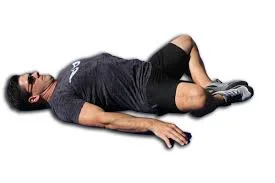
Start with placing one’s face on the ground or a mat with the knees bent and the feet hip-width separated.
When someone presses his or her heels together, their legs must come together in a diamond structure. The starting point is here. Move the heels as close to the pelvis as possible to begin the proper posture; however, if one wishes to experience a stretch in the glutes, one may need to shift the pelvis away from the heels.
By tightening the glutes, you may raise the pelvis off the ground and then walk straight to your knees. A one- to two-second interval should be made at the highest point.
Lower your hips to get back into your starting position. One rep counts. do 5 to 10 repetitions.
session: depends on the capacity
muscle responsible: gluteus, hip flexor, quads
Warrior Balance
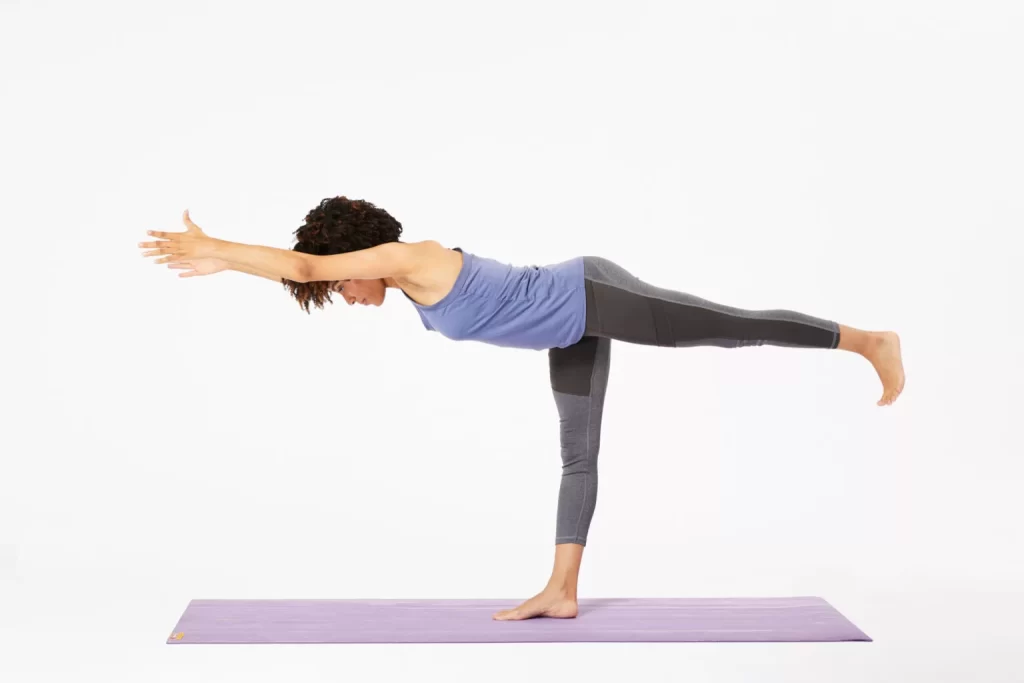
Standing on the left foot, raise the right knee to hip height in front of the body. When people flex their elbows, their hands should be by their sides. The starting position is this.
Move forward at the hips and lengthen the arms while the person stretches their right leg behind them. Keep bending the standing leg as the body aligns with the floor.
then conduct a reverse warrior balance exercise to return to your starting posture. Complete 10 reps of this exercise twice or three times daily.
muscle responsible: hips, legs, arms, upper back
Side lying inner thigh lift
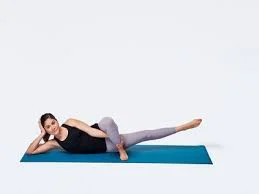
Legs should be straight and extended in front of the wall while on the mat or with the torso held up by the forearm.
When someone crosses their upper leg beyond their lower leg by bending at the knee, the upper foot must be in front of the lower knee. this is the initial point of side lying inner thigh lift.
Gently and steadily raise the lower leg toward the ceiling. Throughout, keep your body straight. Return to your starting position. It’s one rep, then.
make 10 to 15 repetitions.
two to three times per day.
The muscle responsible: inner thigh muscles such as adductor longus, adductor brevis, adductor magnus, pectineus, and gracilis
Squat in sumo
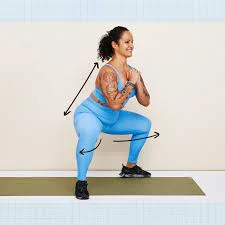
Carry a standing stance with your feet pointed out and your hands by your sides, folded in front of your chest or held out in front of your body.
The person must keep an elevated, straight back and flat chest as they move, with weight shifted to their heels. In order to come down into a position of squat, he or she must push the hips back, extend the front arms, and bend the knees.
Push off the bottoms of the feet and contract the muscles of your glutes once to stand. Do 10 repetitions.
sessions: two to three
Muscle responsible: hamstring, quadriceps, calves, gluteus, adductor longus, adductor brevis, adductor magnus, pectineus, gracilis
Squat to sidestep
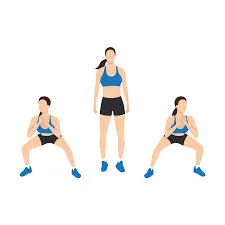
Position yourself standing with your feet together, your abs firm, and your hands at your chest.
Move the right foot to the side, separating the feet such that they are wider than hip-width separated. Once the thighs are pushed back, flex at the hips to come down into a broad squat, bending both knees.
To gain straightening the knees, come back the right foot to its original position. It’s been one round. Complete 10 rounds.
Switch to the other side after doing all of the rounds.
muscle responsible: gluteus medius, quadriceps, inner thigh muscle such as adductor longus, adductor brevis, adductor magnus, pectineus,gracilis
Up and down the plank
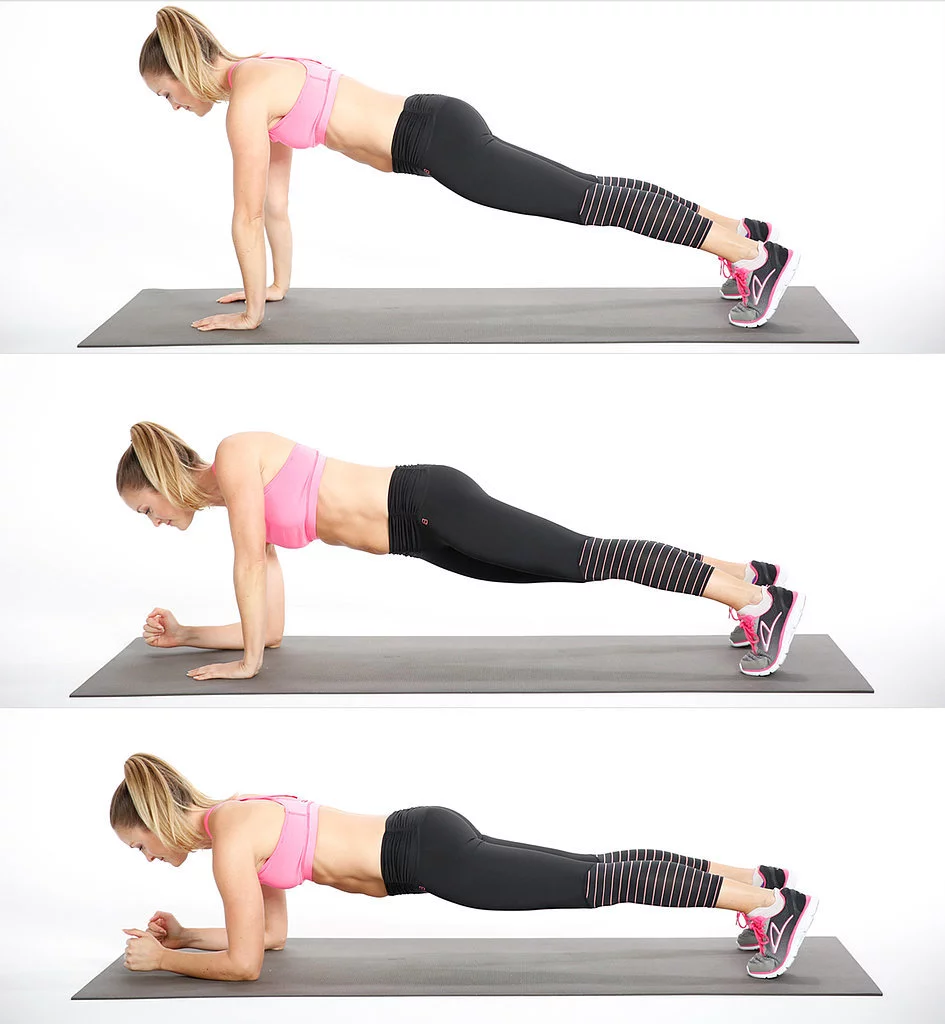
Get into a plank posture on the floor with your hands on the mat, shoulders immediately above them, legs extended behind you in a straight line, toes on the mat, and a straight line extending from the top of the head to your heels. Keep your knees on the ground if that is too tough. You are now in a forearm plank after lowering your left elbow to the floor first, followed by your right elbow. maintain the body in a straight line and the abdominals connected. Straighten your right arm and stand up. Then extend your left arm in the same manner. One set consists of 30 repetitions in which the arm going first is alternated.
muscle responsible: gluteus, core muscles contain rectus abdominis, transverse abdominis, internal and external obliques, multifidus, erector spine, diaphragm,
shoulder muscle contains supraspinatus, infraspinatus, subscapularis, teres minor, etc
arm muscle contains brachialis, brachioradialis, biceps brachii, supinator, pronator, deltoid, triceps brachii, etc
wrist muscle contains extensor carpi radialis longus, extensor carpi radialis brevis, extensor carpi radialis, extensor carpi ulnaris,palmaris longus etc
A-skip
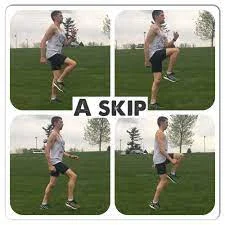
A common field and way workout that prepares the body for greater exertion is the A-skip. A-skips are an excellent way for non-track participants to warm up and prepare their bodies for leg exercises.
How to perform an A-skip:
- As the person is upright, spread their feet to hip width.
- preserving a flexed foot on the lifted leg, strongly raising one knee.
- Lifting the knee while giving force via the ground with the positioned foot, grab the heel off the floor.
- Once the top of the thigh aligns with the ground, proceed by pushing that foot firmly, heel first, to the floor.
- Stand up straight on your toes and lift your heel off the floor to contact the ground when your heel moves.
- Forcefully lift another knee as the person’s positioned foot reaches the ground to make the following skip.
- Include a second side arm swinging upward with the other side knee allowing the arms to hang naturally.
muscle responsible: primarily targets the quads and to a lesser degree also targets the glutes, hamstrings, hip flexors, lower back, and outer thighs.
Bear walk

Start with The person sitting down on the ground with their legs flexed and their hands placed two inches in front of them. Extend your fingers away from your body. Step forward with the right foot while extending the left hand at the same time. Then, while advancing with the left foot, lift the right hand. It must be necessary to walk ahead 10 times.
session: two to three times.
the muscle responsible: upper arm like the Biceps brachii, Brachialis, Coracobrachialis, and Triceps brachii.
Shoulder muscles involve rotator cuff muscles involving the supraspinatus, infraspinatus, teres minor, and subscapularis
Upper leg muscles involve the hamstring, quadriceps femoris
core muscle containing transverse abdominis, multifidus, diaphragm, internal external obliques, erector spine, etc
Back lunge and leg raise
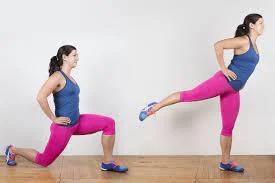
Begin by assuming a standing position with your feet hip-width separated. Then, with the left foot, take one step back and lunge downward. To work the glute and hamstring, straighten the left leg behind the body. Straighten the right leg by applying pressure via the heel. Replace the sidewalls then fall once more into lunge and repeat 5 to 10 times
The muscle responsible: quadriceps muscle like vastus lateralis, vastus medialis,vastus intermedialis, and rectus femoris, The lesser degree also targets the calves such as gastrocnemius, soleus
gluteus muscles
groin muscles
hamstrings muscles like semitendinosus, and semimembranosus. biceps femoris
hip flexors’ major muscles contain sartorius, rectus femoris, tensor fascia latae, and the additional muscle of the hip flexor contains Iliopsoas, Iliacus, Adductor longus, adductor brevis, adductor magnus,gracilis, pectineus, psoas major
outer thighs contains gluteus medius, gluteus minimus
T-Rotations On The Plank
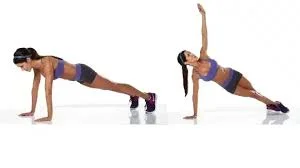
With the feet hip-distance apart, begin in a high plank position.
In a side plank position with your shoulder over your wrists, now turn your complete body to the right.
Keep moving your hips up while raising your right arm to the ceiling.
Repeat on the other side after returning to the center position.
ten repetitions
two times per day.
muscle involved: Core, triceps, shoulders, quads, lower back, lower abs, upper abs, lateral abs.
Side plank rotation with kicks
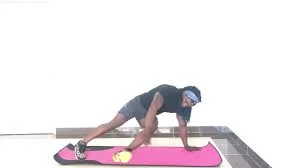
Begin in a high plank position with your abs tightly, shoulders over your wrists, and glutes contracted.
Lifting your left foot, kick the left foot under the body and towards the right side. As you balance on the left arm and right leg, extend the palm of your right hand to contact your left foot.
On the opposite side, repeat.
reps: 10 times
session: twice a day
muscle involved: shoulder muscles like supraspinatus, teres minor, infraspinatus, subscapularis
lattisimus dorsi muscles, glutes, rectus abdominis, transverse abdominis,pyramidialis, the internal external obliques.
Twists to Sit-Ups
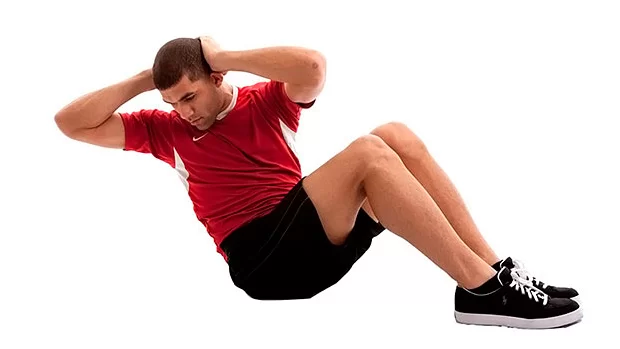
Begin with knees bent slightly and feet flat on the floor, lie on the back.
Conduct a full sit-up while keeping your abdominal muscles engaged and placing your hands behind your head. Move your right elbow to your left knee at the top of the sit-up, then twist your body to the right side.
To begin, move down once again.
This motion should be repeated every time switching sides.
10 to 15 repetitions, three times each day
Muscle involved: internal obliques, external obliques
The Cossack Squat
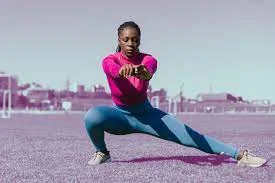
Standing straight and tall with proper posture and toes pointing outward by around 15 degrees.
Sit your hips back and squat down, putting most of the weight on your right leg.
As you extend your left leg outward to the side and touch your left heel on the floor with your toes pointed upward, lean toward your right leg.
Lift the left leg back in while pressing via the right leg to stand back up from the lowest position.
Perform at least 15 repetitions, then switch sides.
twice daily
The muscle involved: The cossack squat targets the quads, hamstrings, glutes, and hip adductors while also working the core, including your abdominals and lower back. The hip, knee, and ankle joints and connective tissues will also be targeted
Advantages bodyweight exercises
- Bodyweight workouts are effective. Short workouts alone can produce amazing benefits, and they can be combined with other exercises to increase performance.
- bodyweight workouts are both cardio and strength exercises. preserve a healthy heart rate while achieving flexibility and muscle.
- bodyweight workouts are incredible in burning fat. The after-workout burn lasts forever. For instance, a 45-minute workout elevates the body’s rate of fat burning for 14 hours.
- You may easily change things up. No need to clean and change out the equipment and there are no limitations on how you can work out based on your skill level. Bodyweight exercises are challenging, so you won’t likely feel fatigued.
Health and safety criteria
When training on the bodyweight workout, form is important. The person generally should not want her/his knees to extend too far past her/his toes when performing any squat or lunge movement. To avoid putting further strain on the knee, avoid doing this. The doctor would prefer that this squat or lunge happen as infrequently as possible, while it is acceptable if it happens by accident.
The outline
Leg exercises that solely use your own body weight are a great way to improve your functional fitness and train key movement patterns.
The squat and lunge movements should be the primary level of training available for serious bodyweight workouts.
More exercises for the lower body are required in order to provide variation, warm up, and increase mobility.
Bodyweight exercises should be changed to focus on different fitness goals, such as strength or healthiness.
The need for external power should eventually be necessary to continue strengthening.
Bodyweight exercises should always be used for achieving cardiovascular fitness.
The finest thing is that the person may do these exercises at home, at any time. The next time he or she needs a way to get the blood circulating after spending prolonged time in a seated position, attempt some of these activities
FAQs
Should bodyweight exercise be performed everywhere, at any time?
Bodyweight exercises, fortunately, don’t need a specific gym, so you may work out anytime you have some free time, wherever you are. Bodyweight exercises also let you mix both cardio and strength training, allowing you to complete the workout quickly and effectively.
Should we perform exercises using only our bodies?
They can easily be incorporated throughout the day in smaller doses because they don’t take up a lot of time or space. The health advantages of bodyweight workouts, such as better muscular tone, mobility, flexibility, and general strength, can be significant.
How long do bodyweight exercises need to be?
Depending on the person, their goals, their tastes, and the exercise type, the appropriate workout length might vary greatly. 45 to 60 minutes per exercise may be sufficient for bodyweight workouts and lifting. While performing calisthenics and aerobic exercises for 30 to 60 minutes might be preferable.
How many bodyweight exercises should an individual perform in a set?
Start with two sets of 15 reps if you’r just starting out, and as you gain strength, up the amount of sets. Before beginning any fresh exercise program, consult your doctor if you have an injury or disease that could impair your capacity to exercise securely.
Is using your own body weight safer than using weights?
On the one hand, lifting weights might result in quicker, more powerful muscles. On the other hand, bodyweight exercise may improve your health, flexibility, and resistance to injury.
Do activities involving your own body make strength or muscle?
Bodyweight workouts help the person develop more than just strength and muscle. Additionally, additional fitness-related skills including coordination, balance, and flexibility are being developed.
Do bodyweight exercises help you lose weight?
Although using your own body weight to exercise has some obvious advantages, such as calorie burning and muscle building, it is not recommended to do this one exercise every day. Lifting weights is crucial for comprehensive health benefits.
How many bodyweight workouts are there per muscle group?
Depending on how many repetitions you perform, you might perform 2–5 sets of 4–8 exercises for each muscle group throughout a workout or 6–14 each week. The rep range for each exercise should be smaller for strength increases than for muscular growth or endurance. Per session, aim for 3-6 reps.
Do you need to do bodyweight exercises?
Bodyweight exercises can simultaneously increase your muscular strength and cardiovascular endurance, which is one of their most significant advantages. By shifting positions and raising your heart rate, you receive a cardio workout, and force and body weight combine to assist you in gaining muscle.
What exercise using only body weight is the most effective?
certainly, the best Bodyweight Exercise is the push ups. Everyone should be capable of performing pull-ups since lifting one’s own body weight feels really basic. Push-ups are a complex exercise that engages practically all of the upper and lower body’s muscles, working numerous muscle groups.
What is the maximum amount of muscle you can normally add?
In their lifetimes, most males can normally put on 40 to 50 kilograms of muscle, while most women can do the same with 20 to 25 kilograms. you can estimate how much muscle you will naturally add by measuring the diameter of your wrists and ankles.
Which muscle grows most slowly?
Like with any form of exercise, a number of variables might affect how long it takes to build muscle. smaller muscles need less time to develop than larger ones consider the forearms versus the quads, and a variety of individual factors, including age, gender, health history, and nutrition, must have a significant affect on the final conclusion.
References
CPT, B. L., & Tucker, A.53 At-Home Bodyweight Exercises SELF (https://www.self.com/gallery/bodyweight-exercises-you-can-do-at-home)Date accessed 3/10/2017
Brookes, G.51 Body Weight Exercises You Can Do Anywhere Without Equipment. Kettlebell Workouts by Greg Brookes(https://kettlebellsworkouts.com/bodyweight-exercises/)Date accessed 5/5/2023
Schwecherl, L.50 Exercises for a Bodyweight Workout You Can Do Anywhere. Greatist. (https://greatist.com/fitness/50-bodyweight-exercises-you-can-do-anywhere#chest-and-back)Date accessed 25/09/2020
D.50 Best Exercises for a Bodyweight Workout. blog.decathlon.in. (https://blog.decathlon.in/articles/bodyweight-workout)Date accessed 16/12/2019
Lawler M. Body-weight exercises for Arms, Legs, Core, and More. EverydayHealth.com. (https://www.everydayhealth.com/fitness/the-best-bodyweight-exercises-for-working-out-every-part-of-your-body/)Date accessed 10/07/2023

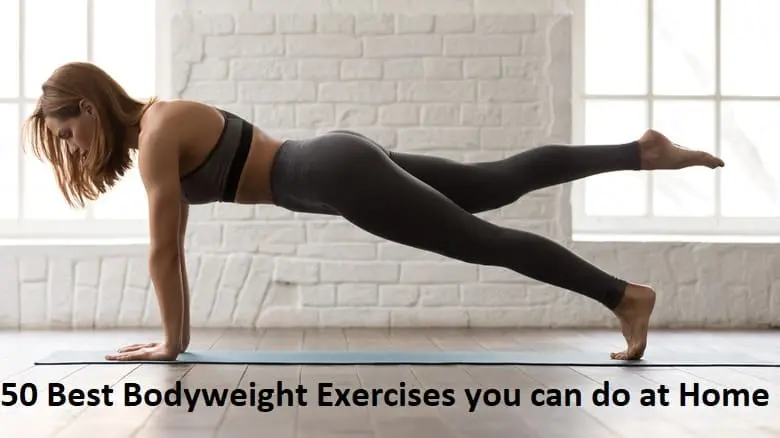

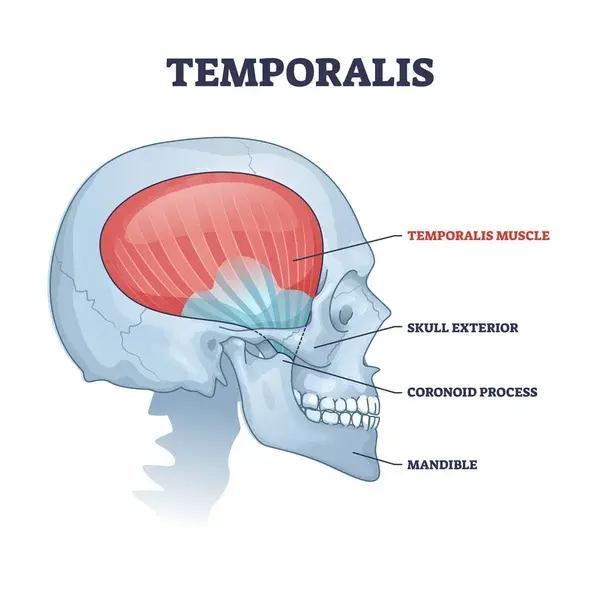

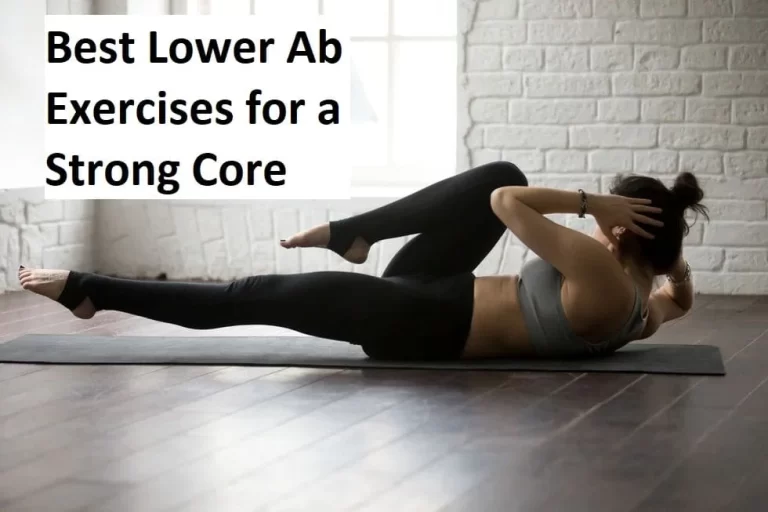
4 Comments